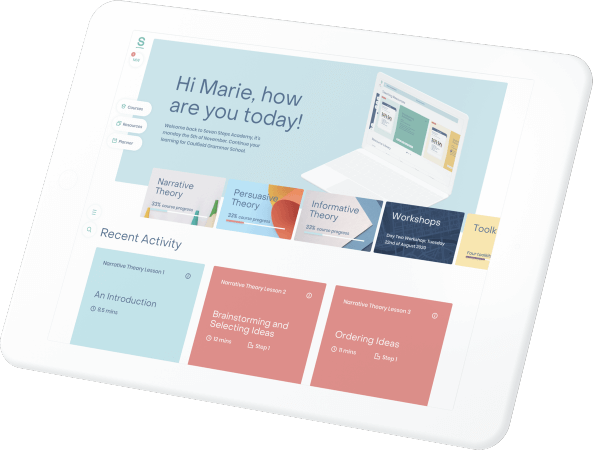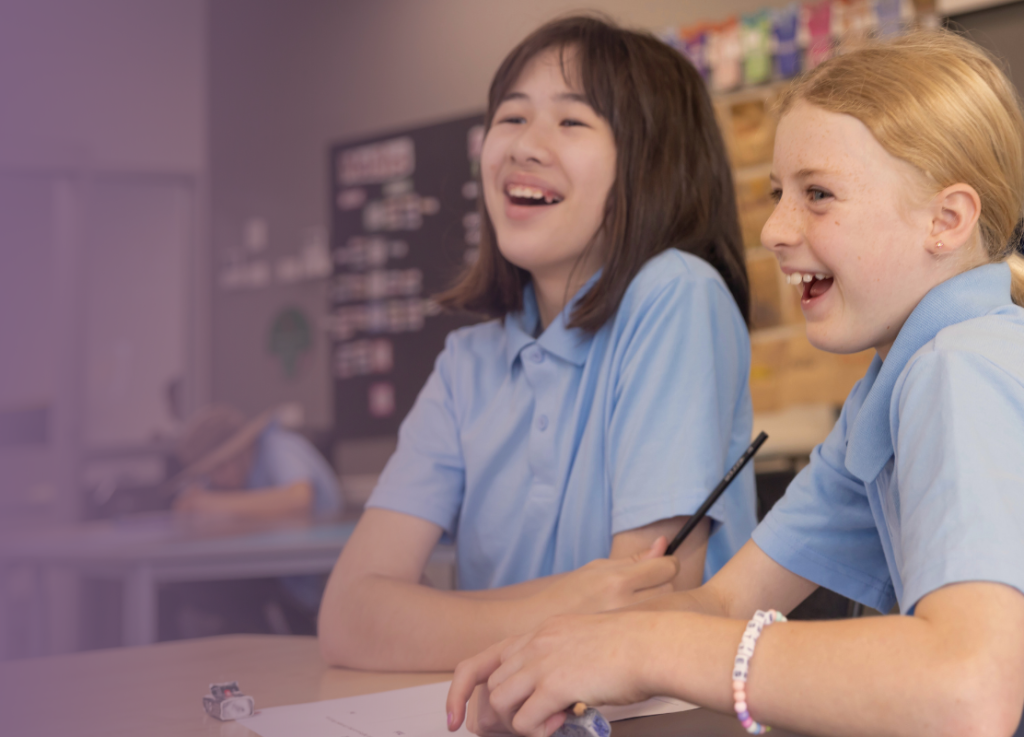No products in the cart.

5 min

Classroom Activities

Admin SEVEN STEPS
Teachers often tell us that one great pain they wish to change is how little their students have to say. Students’ writing, they tell us, is often curtailed by limited experience and a lack of observation, or by unformed opinions.
We understand why teachers say this, but we don’t think it’s the whole story.
Every writer today is awash in an ocean of information: memes, GIFs, TikTok, Snapchat, Instagram, advertising, movie trailers and dozens of other attractive options for consuming – rather than creating – ideas.
It’s no wonder students are overwhelmed or unsure how to begin.
Kids might need to be taught that their ideas matter, even if those ideas are unformed at first (in contrast to that flood of highly developed ‘stuff’ coming in).
We can tell them that weak ideas are absolutely okay. Why? Because a weak idea nearly always leads to better ideas if you keep going.
We need to help students to keep pushing through to the ‘Alpha’ brain state in which the brain spins freely, and open association means ideas can be formed from seemingly unconnected things.

One step towards creativity
Step 1: Plan for Success is a powerful step. It includes the whole business of making, finding, collaborating and assembling ideas. Mastering Step 1 has a huge impact on student writing.
You could say Step 1 is ALL about ideas because a plan is only possible when you have something to say. First get ideas, then sort ideas, and finally, plan a structure using your ideas.
Let’s teach students how to spot an idea even when it’s just a glimmer, coax it out gently (ideas have a habit of hiding), and use it to generate more.
Here are two ways to do this to show students how to create ideas – and show them that their ideas are worth building upon

2 great ways to hunt for ideas + a bonus tip
1. Word association game
Part of the secret behind the Seven Steps is that students ‘talk to write’, and we practise, practise, practise. This one’s not new, but there are lots of ways to play it:
- Provide each student with one word, such as chicken, basketball, orange, blue, elephant, sunset, run, fly, ball, dog, sport, play, sandwich, grow, beard, guitar, make, spy, hat, jump, magic, racehorse, cloud, star, speedboat, explode.
- In pairs, students make a sentence using both words and write it down (e.g. The chicken played guitar). Go quickly, no pressure.
- They then each think of one word that the sentence conjures up for them (e.g. Gee that would be noisy. Wouldn’t a chicken need fingers to play guitar?).
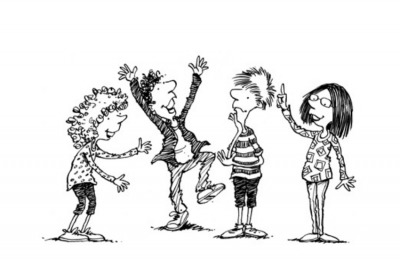
- Each pair should now have four words (e.g. chicken, guitar, noisy, fingers).
- Have pairs get together with another pair and share all eight words (e.g. orange, ball, secret, hot – PLUS – chicken, guitar, noisy, fingers).
- They use any two of their words plus anything else to make a story topic or scenario (e.g. Chicken has secret life.) Note that these are not titles, they’re scenarios.
- Tell groups they can add starters such as ‘The day when …’ ‘What if …’ and ‘In a land where …’ (e.g. ‘The day my guitar revealed my secret’).
- If any groups get stuck, let the whole class work together until you have loads of topics.
This activity gets easier with practice – which is the point! Try it several times to see if idea generation becomes less daunting.
Remember, students are just generating topics (ideas), not writing full texts using the words. Loosen the rules as they get better at it – allow them to bring in more new words of their own at any point.
Variation
Try adding a word pulled randomly from a hat, trading word cards between pairs, rolling dice or using The Chatterbox template below. Students can ‘phone a friend’ (combine the word with theirs), or ask the class to call out an adjective and add it to the sentence.
Have a few books available and get students to open the book at random and add the 12th or 22nd or 31st word to their set.
Generate lots of topics, post them around the classroom and after this activity is familiar, let students choose one to write about.

Free template
The Chatterbox template is a random ideas generator that can create over 500 unique story ideas!
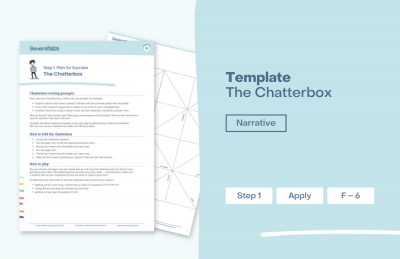

2. Picture writing prompts
Visual writing prompts can help unleash students’ imaginations and creative thinking skills.
Our prompts focus on just one Step at a time, breaking down writing skills into manageable chunks and providing a fun way to practise those skills until they become engrained.
Using writing prompts daily or weekly is a really achievable way to build students’ confidence in their narrative, persuasive and informative writing.
For something different, provide pairs of students with a writing prompt but only allow one student in each pair to see it. That student describes what they see and their partner writes what that inspires them about character, setting and plot.
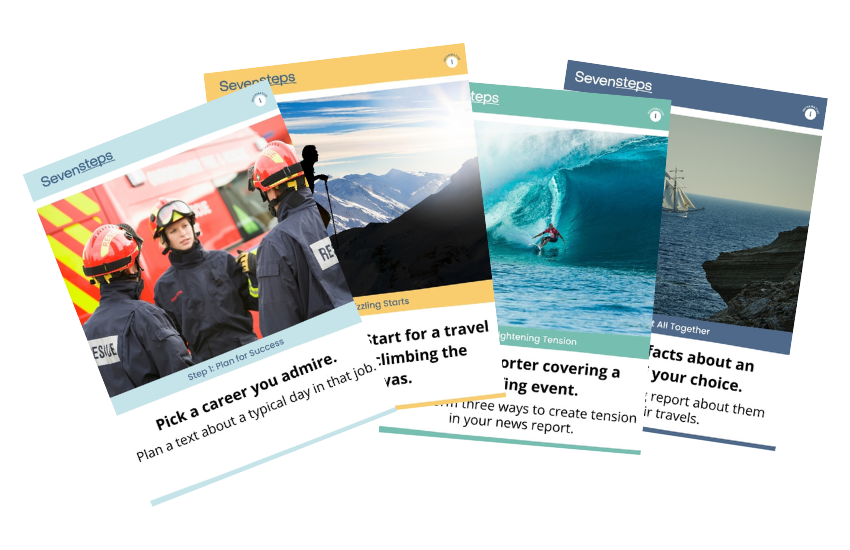
Free writing prompts

Bonus tip
Brainstorm in groups! Provide a prompt or game, get students in groups and let them get started. Give them a short time frame (1-2 minutes), then have them move, mix up the groups and go to another prompt.
Keep mixing, keep moving (the blood keeps flowing), play music – let students be noisy.
Ideas might be shy beasts, but they can’t resist the fun of a game.

Further resources
A simple tech tool for more word association fun: WordStorm, the brainstorming tool (needs Flash)
Blog posts: Top three brainstorming tips and Creativity in the classroom


